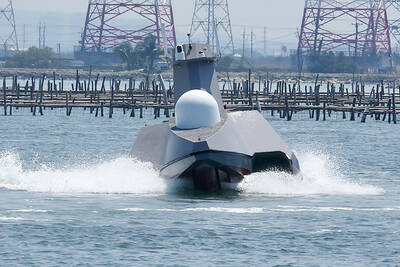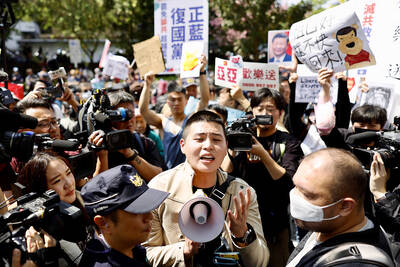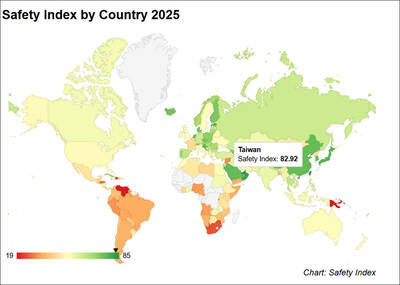The Chinese Nationalist Party (KMT) is nearly 80 times richer -- in total asset terms -- than the Democratic Progressive Party (DPP), figures from the Ministry of the Interior show.
The KMT has assets worth more than NT$27 billion (US$821 million), while the DPP's assets amount to nearly NT$339 million.
In a rare peek at hard numbers from political parties' financial statements, some surprising information about the top parties appeared on the ministry's Web site yesterday (www.moi.gov.tw/home/home.asp).
Although it is no secret that the KMT possesses copious assets -- much of which its critics allege it plundered after Taiwan ceased to be a Japanese colony -- it might surprise some to know that the DPP's income for last year was more than double that of the KMT.
The DPP earned NT$661 million while the KMT pulled in a little more than NT$301 million.
In terms of net assets, the KMT boasts 100 times more asset value, or roughly NT$25.5 billion, to the DPP's nearly NT$253 million, the records show.
But the KMT is also saddled with more debt, nearly NT$1.6 billion as of last year, compared with the DPP's nearly NT$86 million.
And the People First Party (PFP) is flat broke.
With more than NT$144 million in debts, the PFP is some NT$134 million in the red, making it the only one of the four major parties to be running a deficit, the records show.
The posting on the ministry's Web site simply listed the figures provided by each party. An explanation on how they were derived was not given.
Minister of the Interior Lee Yi-yang (
The release of the records was part of the ministry's plan to allow the public to scrutinize political party finances ahead of the next legislative and presidential polls.
Announced last November, the ministry's plan was to post online the annual income and financial statements of parties and other political organizations with earnings of at least NT$30 million by Jan. 1.
Seven months later, however, the ministry has managed to coax only 19 of the nearly 170 parties and political organizations into giving the public a peek at their books.
Lee said that while posting the figures was a ministry requirement, there were no legal consequences for not submitting the data.
"Some parties rarely do anything and thus probably don't have anything to declare," Lee said. "Another reason for the low rate of cooperation is the ministry has to rely on the parties taking the initiative to cooperate."
DPP caucus whip Wang Sing-nan (王幸男) challenged the KMT's declaration of its assets, saying it had concealed stolen assets.
Wang said when he and some 20 DPP lawmakers went to the KMT's headquarters in June last year to demand the return of the KMT's stolen assets, the director of the KMT's Policy Research Committee said the party had NT$60 billion in assets.
He questioned how the value of the KMT's assets could have declined so much in just a year.
Wang didn't name names, but Tseng Yung-chuan (
When asked by reporters for response yesterday, Tseng said he did not meet with Wang in June last year and the party had never said it had more than NT$60 billion in assets.
Since the party lost power in 2000, it has downsized considerably. Hundreds of workers have been laid off and the party sold its Zhongshan S Road headquarters last year to cut expenses.
In August 2005, Ma Ying-jeou (
On Aug 23 last year, the party released a report on its assets that said it had NT$27.7 billion in assets, compared with NT$38.5 billion when former president Lee Teng-hui (
Additional reporting by Flora Wang, Shih Hsiu-chuan and staff writer

ENDEAVOR MANTA: The ship is programmed to automatically return to its designated home port and would self-destruct if seized by another party The Endeavor Manta, Taiwan’s first military-specification uncrewed surface vehicle (USV) tailor-made to operate in the Taiwan Strait in a bid to bolster the nation’s asymmetric combat capabilities made its first appearance at Kaohsiung’s Singda Harbor yesterday. Taking inspiration from Ukraine’s navy, which is using USVs to force Russia’s Black Sea fleet to take shelter within its own ports, CSBC Taiwan (台灣國際造船) established a research and development unit on USVs last year, CSBC chairman Huang Cheng-hung (黃正弘) said. With the exception of the satellite guidance system and the outboard motors — which were purchased from foreign companies that were not affiliated with Chinese-funded

PERMIT REVOKED: The influencer at a news conference said the National Immigration Agency was infringing on human rights and persecuting Chinese spouses Chinese influencer “Yaya in Taiwan” (亞亞在台灣) yesterday evening voluntarily left Taiwan, despite saying yesterday morning that she had “no intention” of leaving after her residence permit was revoked over her comments on Taiwan being “unified” with China by military force. The Ministry of the Interior yesterday had said that it could forcibly deport the influencer at midnight, but was considering taking a more flexible approach and beginning procedures this morning. The influencer, whose given name is Liu Zhenya (劉振亞), departed on a 8:45pm flight from Taipei International Airport (Songshan airport) to Fuzhou, China. Liu held a news conference at the airport at 7pm,

Taiwan was ranked the fourth-safest country in the world with a score of 82.9, trailing only Andorra, the United Arab Emirates and Qatar in Numbeo’s Safety Index by Country report. Taiwan’s score improved by 0.1 points compared with last year’s mid-year report, which had Taiwan fourth with a score of 82.8. However, both scores were lower than in last year’s first review, when Taiwan scored 83.3, and are a long way from when Taiwan was named the second-safest country in the world in 2021, scoring 84.8. Taiwan ranked higher than Singapore in ninth with a score of 77.4 and Japan in 10th with

GRIDLOCK: The National Fire Agency’s Special Search and Rescue team is on standby to travel to the countries to help out with the rescue effort A powerful earthquake rocked Myanmar and neighboring Thailand yesterday, killing at least three people in Bangkok and burying dozens when a high-rise building under construction collapsed. Footage shared on social media from Myanmar’s second-largest city showed widespread destruction, raising fears that many were trapped under the rubble or killed. The magnitude 7.7 earthquake, with an epicenter near Mandalay in Myanmar, struck at midday and was followed by a strong magnitude 6.4 aftershock. The extent of death, injury and destruction — especially in Myanmar, which is embroiled in a civil war and where information is tightly controlled at the best of times —